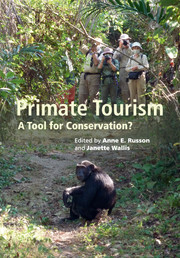Book contents
- Frontmatter
- Contents
- List of contributors
- Part I Introduction
- Part II Asian primates
- Part III African primates
- 7 Lemurs and tourism in Ranomafana National Park, Madagascar
- 8 Some pathogenic consequences of tourism for nonhuman primates
- 9 Baboon ecotourism in the larger context
- 10 Mountain gorilla tourism as a conservation tool
- 11 Evaluating the effectiveness of chimpanzee tourism
- Part IV Neotropical primates
- Part V Broader issues
- Part VI Conclusion
- Index
- References
8 - Some pathogenic consequences of tourism for nonhuman primates
from Part III - African primates
Published online by Cambridge University Press: 05 September 2014
- Frontmatter
- Contents
- List of contributors
- Part I Introduction
- Part II Asian primates
- Part III African primates
- 7 Lemurs and tourism in Ranomafana National Park, Madagascar
- 8 Some pathogenic consequences of tourism for nonhuman primates
- 9 Baboon ecotourism in the larger context
- 10 Mountain gorilla tourism as a conservation tool
- 11 Evaluating the effectiveness of chimpanzee tourism
- Part IV Neotropical primates
- Part V Broader issues
- Part VI Conclusion
- Index
- References
Summary
Introduction
As should be obvious to anyone who has ever encountered primatologists and their obsessions, nonhuman primates can hold a strong emotional and intellectual sway. One appeal of nonhuman primates is their sheer variability. They occupy rainforest, desert, mountains, and grasslands. They can live in habitats ranging from the snows of Japan to the heat of Ethiopia. Their social structures include cooperative breeders, such as marmosets, and markedly uncooperative ones, such as savanna baboons, pair-bonded gibbons, and polygamous and polyandrous bonobos. There are also solitary orangutans and hamadryas who live in a complex, multi-tier system of small stable harems of half a dozen or so individuals that can temporarily merge into collections of hundreds of individuals.
Another realm of variability in primates is in their diet. At one extreme are species such as the mountain gorilla, whose diet is sufficiently narrow and specialized as to play a role in its endangerment. And at the other are opportunistic omnivores that flexibly exploit a wide array of food resources. Among the most extreme examples of the latter are savanna baboons. These species eat grass blades and corms, parts of trees, shrubs and tubers, insects, and they both hunt and scavenge meat. This has allowed baboons to successfully occupy the grasslands, forests, and arid highlands of Africa.
- Type
- Chapter
- Information
- Primate TourismA Tool for Conservation?, pp. 147 - 154Publisher: Cambridge University PressPrint publication year: 2014
References
- 5
- Cited by



